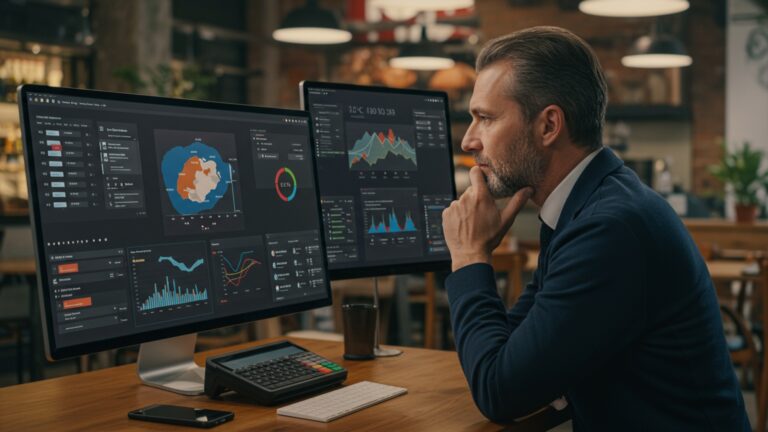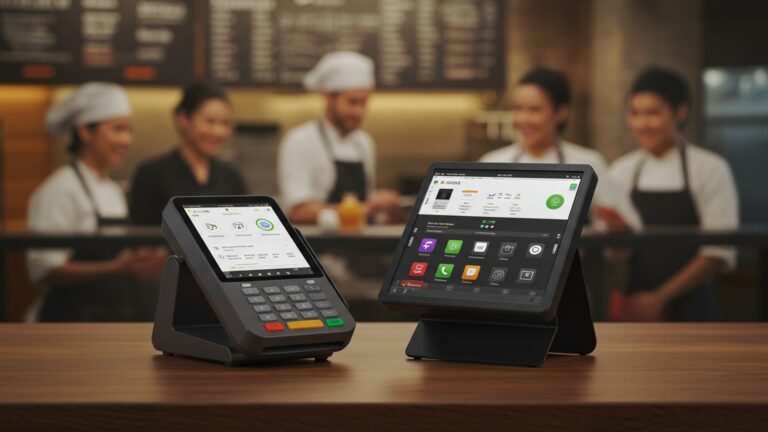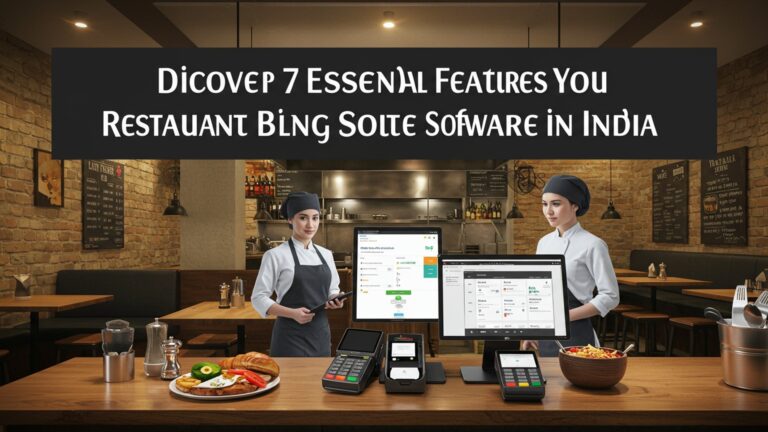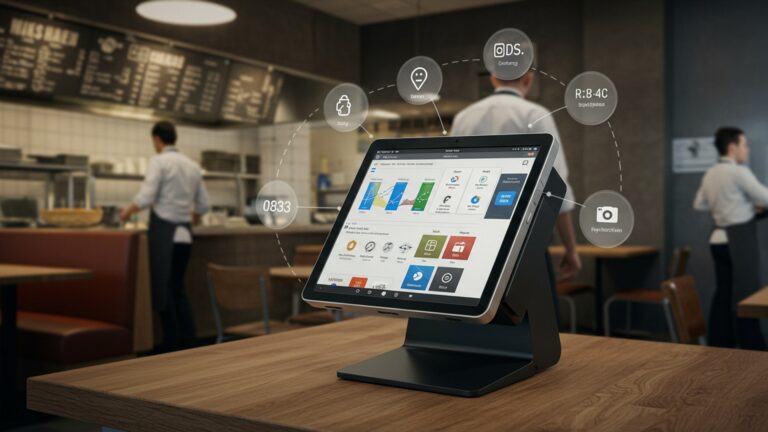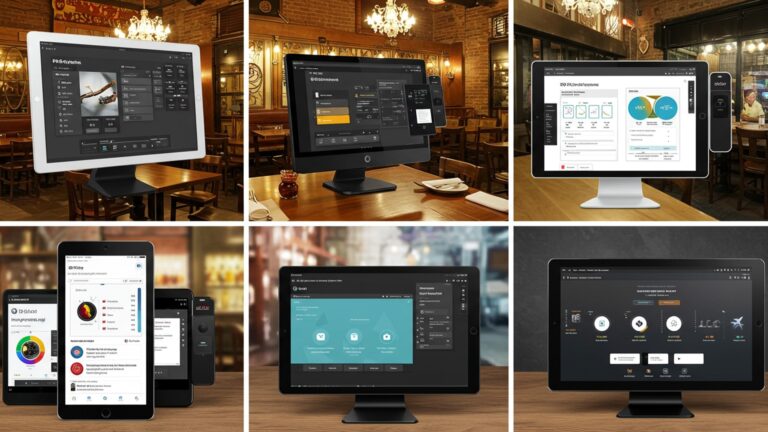Master Restaurant Billing Software India Choose Your Perfect System
The bustling Indian culinary scene demands more than just great food; it requires seamless operations, especially at the point of sale. From managing diverse menus with complex pricing to ensuring precise GST compliance and integrating with popular delivery platforms like Zomato, the modern restaurateur faces myriad challenges. A robust restaurant billing software India is no longer a luxury but a strategic asset, transforming chaotic peak hours into smooth service flows. Cloud-based solutions, for instance, now offer real-time inventory tracking and mobile ordering via QR codes, directly impacting profitability and customer satisfaction. Choosing the perfect system means navigating a landscape of features, from advanced analytics to integrated payment gateways, all critical for optimizing efficiency and securing a competitive edge in today’s dynamic market.
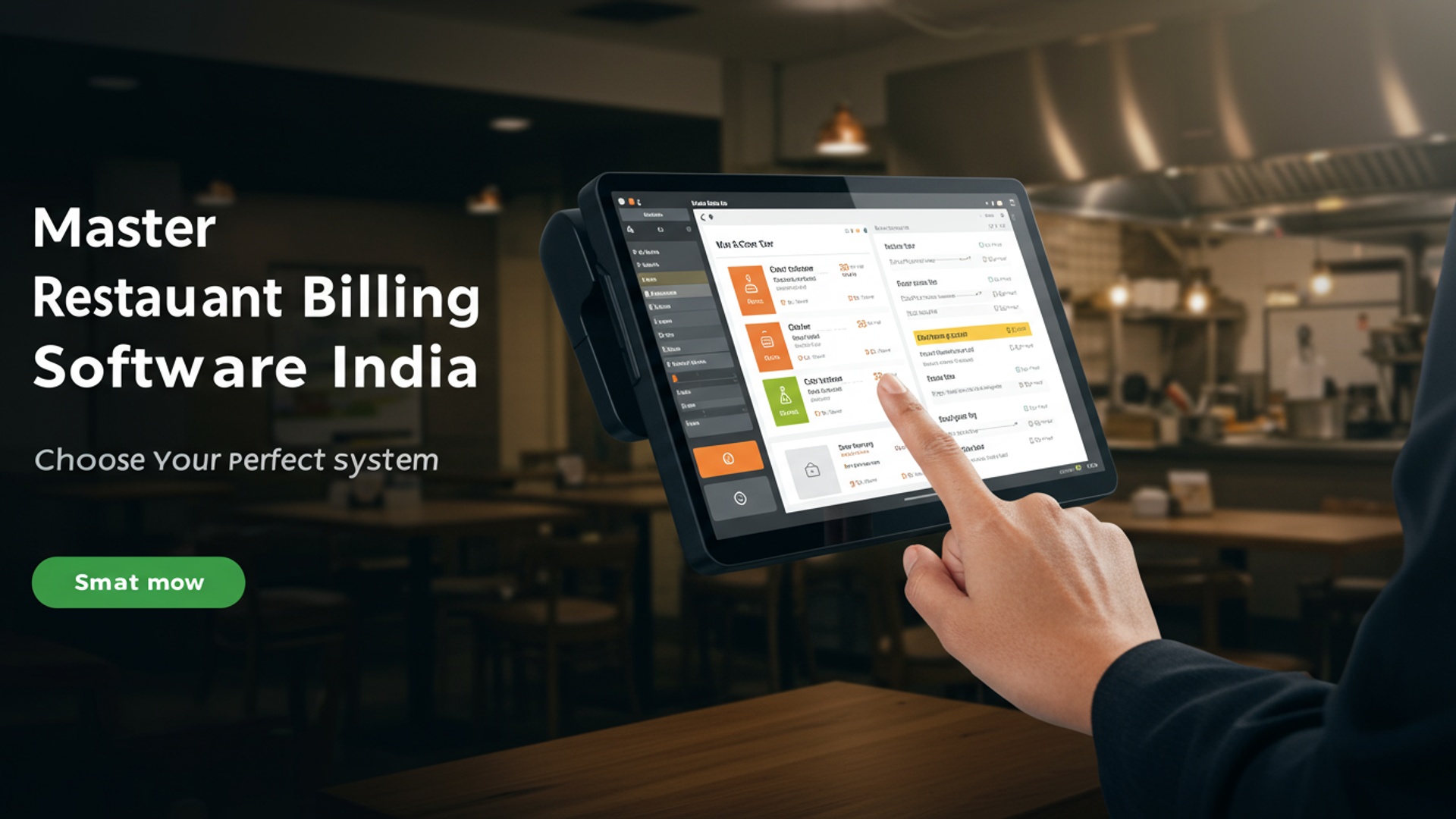
Understanding Restaurant Billing Software: More Than Just a Cash Register
In today’s fast-paced culinary landscape, a restaurant’s efficiency hinges significantly on its operational backbone. At the heart of this is the restaurant billing software, a comprehensive digital system designed to streamline all transactional and operational processes within an eatery. Far from being a mere digital cash register, modern restaurant billing software in India integrates various crucial functions, transforming how businesses manage orders, payments, inventory. customer relationships.
At its core, restaurant billing software facilitates the order-to-payment cycle. This begins when a customer places an order, which is then digitally recorded, sent to the kitchen. eventually presented as a detailed bill. Beyond this fundamental process, these systems offer a multitude of features that address the complex demands of the hospitality industry. Think of it as the central nervous system for your restaurant, connecting front-of-house operations with back-of-house management, all while ensuring accuracy and speed.
Why Your Indian Restaurant Needs Modern Billing Software
The Indian food and beverage industry is dynamic and highly competitive, characterized by diverse customer preferences, evolving regulatory environments. a significant push towards digital transformation. Relying on manual billing or outdated systems can severely hinder growth and operational efficiency. Here’s why a robust restaurant billing software India is not just an option. a necessity:
- Enhanced Efficiency and Speed
- Accurate Inventory Management
- Seamless GST Compliance
- Improved Customer Experience
- Data-Driven Decision Making
- Integration with Online Delivery Platforms
Manual order taking and billing are prone to errors and delays. Software automates these processes, leading to faster table turnover and reduced waiting times for customers.
Food waste is a major concern. Integrated inventory modules track ingredient consumption in real-time, helping minimize spoilage and optimize procurement. Imagine knowing exactly how many portions of butter chicken were sold and how much raw material is left, preventing both stockouts and excess inventory.
Navigating India’s Goods and Services Tax (GST) framework can be complex. Modern restaurant billing software India automates GST calculations, generates compliant invoices. simplifies tax filing, reducing the risk of penalties. This feature alone is invaluable for any restaurant owner.
Quick service, accurate orders. diverse payment options (including UPI, mobile wallets. cards) contribute to higher customer satisfaction. Many systems also support loyalty programs, encouraging repeat business.
The software collects vast amounts of data on sales, popular dishes, peak hours. staff performance. This data, when analyzed, provides actionable insights for menu engineering, staffing optimization. marketing strategies.
With the rise of Swiggy, Zomato. other aggregators, integration capabilities are crucial. Many systems now centralize orders from multiple platforms directly into the POS, preventing manual entry errors and streamlining operations.
Key Features to Look for in Restaurant Billing Software India
When evaluating restaurant billing software India solutions, certain features stand out as essential for optimal performance and growth. Prioritizing these will ensure your investment yields significant returns:
- Point of Sale (POS) System
- Table management and order routing to kitchen/bar.
- Split billing and KOT (Kitchen Order Ticket) management.
- Customizable menu with modifiers and combos.
- Inventory Management
- Customer Relationship Management (CRM)
- Reporting and Analytics
- Online Ordering & Delivery Integration
- Payment Gateway Integration
- GST Compliance
- Staff Management
- Multi-Outlet Support
- Kitchen Display System (KDS)
This is the core. It should be intuitive, user-friendly. capable of handling various order types (dine-in, takeaway, delivery). Key POS features include:
Tracks raw materials, prepared dishes. supplier details. Critical for cost control and preventing waste.
Manages customer data, loyalty programs. feedback, enabling personalized marketing and improved service.
Generates detailed reports on sales, profits, popular items, staff performance. more. Essential for strategic planning.
Connects directly with your website’s online ordering portal and third-party delivery aggregators, streamlining order flow.
Supports multiple payment methods including cash, credit/debit cards, UPI. mobile wallets, catering to the diverse payment preferences in India.
Automatically calculates and applies GST, generating tax-compliant invoices and simplifying tax filing.
Manages employee shifts, attendance. calculates commissions or tips, improving workforce efficiency.
For growing businesses, the ability to manage multiple branches from a single dashboard is invaluable.
Replaces paper KOTs with digital screens in the kitchen, improving order accuracy and speed.
Types of Restaurant Billing Software: Cloud vs. On-Premise
Choosing the right deployment model is a critical decision when selecting restaurant billing software India. The two primary types are Cloud-based and On-premise solutions, each with distinct advantages and disadvantages.
| Feature | Cloud-Based Software | On-Premise Software |
|---|---|---|
| Deployment | Hosted on remote servers, accessed via internet browser. | Installed directly on your restaurant’s local servers and computers. |
| Cost Structure | Subscription-based (monthly/annual fees), lower initial investment. | High upfront cost for hardware, software license. installation. |
| Accessibility | Access from anywhere, on any device with an internet connection. Ideal for multi-outlet management. | Limited to the local network; remote access often requires complex VPN setups. |
| Maintenance & Updates | Managed by the vendor; automatic updates and backups. | Restaurant is responsible for hardware maintenance, software updates. data backups. |
| Scalability | Easily scalable; add more users or features as your business grows. | Scaling often requires significant hardware upgrades and reinstallations. |
| Data Security | Vendor is responsible for security, often with robust protocols. Relies on internet security. | Restaurant is responsible for its own data security and disaster recovery. |
| Internet Dependency | Requires a stable internet connection for full functionality (though some offer offline modes). | Operates without internet once installed. updates and remote support need connectivity. |
| Customization | Generally less customizable. offers broad feature sets. | More customizable to specific, unique operational needs. |
| Ideal For | Small to medium-sized restaurants, multiple outlets, those seeking flexibility and lower TCO. | Large, established restaurants with specific, complex needs and dedicated IT staff. |
For most Indian restaurants, especially startups and those looking for rapid expansion, cloud-based restaurant billing software India often presents a more attractive and cost-effective solution due to its flexibility, lower upfront costs. ease of maintenance.
Beyond Billing: Advanced Functionalities for Growth
The right restaurant billing software in India can do much more than just process transactions. It can be a powerful tool for strategic growth, offering advanced functionalities that optimize every aspect of your business:
- Table Reservation Management
- Loyalty Programs and Discounts
- Menu Engineering
- Staff Performance Tracking
- Supplier Management
- Centralized Kitchen/Warehouse Management
- Business Intelligence (BI) Dashboards
Integrate booking systems directly into your POS, allowing customers to reserve tables online and helping you manage seating capacity efficiently.
Implement sophisticated loyalty programs, offer targeted discounts. manage gift cards. This helps in retaining customers and increasing their lifetime value.
Use sales data to identify your most profitable dishes and those that are underperforming. This allows you to refine your menu for maximum revenue and customer satisfaction.
Monitor individual staff performance, including sales per server, order accuracy. customer feedback. This aids in training, incentives. scheduling.
Keep track of supplier details, purchase orders, delivery schedules. payment terms, ensuring smooth procurement and strong vendor relationships.
For multi-outlet operations, a centralized system can manage inventory and recipes across all locations, ensuring consistency and cost control.
Visual dashboards provide a quick, comprehensive overview of key performance indicators (KPIs), allowing owners and managers to make informed decisions at a glance.
Choosing the Right Restaurant Billing Software India: A Step-by-Step Guide
Selecting the perfect restaurant billing software India requires careful consideration. Follow these steps to make an informed decision:
- Assess Your Specific Needs
- What type of restaurant do you operate (QSR, fine dining, cafe, bar)?
- What is your budget for software and hardware?
- How many outlets do you have, or plan to have?
- What are your biggest operational challenges that software could solve (e. g. , inventory waste, slow service, GST compliance)?
- Research and Shortlist Vendors
- Request Demos
- Check for Key Features
- Evaluate Support and Training
- Consider Scalability
- Read Reviews and Ask for References
Look for providers with a strong presence and positive reviews in the Indian market. Check their experience with similar restaurant types. Platforms like G2, Capterra. even local business directories can be good starting points.
Schedule personalized demonstrations with your shortlisted vendors. Pay close attention to the user interface, ease of use. how well the software addresses your specific requirements. Involve your staff who will be using the system daily.
Refer back to the list of essential and advanced features. Ensure the software offers what you need, including robust GST compliance, multiple payment options. integration capabilities relevant to India’s digital ecosystem.
Post-sales support is crucial. Inquire about their customer service channels (phone, email, chat), response times. available training resources. A local support team can be a significant advantage.
Choose a system that can grow with your business. If you plan to expand, ensure the software can easily accommodate additional outlets, increased transaction volumes. new functionalities.
See what other restaurant owners are saying. If possible, speak to existing clients of the software provider to get real-world feedback on their experience.
Don’t rush the decision. A thorough evaluation process will ensure you invest in a system that truly empowers your restaurant’s operations and growth.
Real-World Impact: A Case Study of “Spice Route Bistro”
Let’s consider “Spice Route Bistro,” a fictional but typical mid-sized Indian restaurant in Bangalore struggling with operational inefficiencies. Before implementing a modern restaurant billing software India, they faced numerous challenges:
- Manual KOTs
- Inventory Headaches
- GST Confusion
- Fragmented Online Orders
Orders were handwritten, leading to frequent errors and delays between the dining area and the kitchen. This resulted in customer complaints and food wastage.
Stock counts were done manually, often inaccurately. They frequently ran out of popular ingredients or had excess perishable stock spoiling.
Calculating GST for each bill was time-consuming and error-prone, causing anxiety during tax filing.
Orders from Swiggy and Zomato came in on separate tablets, requiring manual entry into their basic billing system, leading to double-entry errors and delays.
The owner, Mr. Sharma, decided to invest in a cloud-based restaurant billing software India solution. Here’s what happened:
- Seamless Order Flow
- Optimized Inventory
- Effortless GST
- Centralized Online Orders
- Data-Driven Growth
With a new POS and integrated KDS, orders taken on tablets instantly appeared on kitchen screens. Accuracy improved by 95%. average order delivery time dropped by 15%.
The software automatically deducted ingredients from inventory as dishes were sold. Mr. Sharma could now see real-time stock levels and receive automated alerts for low stock. Food waste reduced by 20% in the first six months.
All bills were automatically GST compliant. monthly reports for tax filing were generated with a single click. This significantly reduced accounting workload and eliminated compliance worries.
The software integrated with major food delivery platforms. All online orders now flowed directly into the POS, appearing alongside dine-in orders, eliminating manual entry and improving order processing speed.
Mr. Sharma started using the analytics dashboard to identify peak hours, best-selling dishes. staff performance. He realized their vegetarian thali was a huge hit during lunch and strategically promoted it, increasing sales by 10%.
Within a year, “Spice Route Bistro” saw a 25% increase in customer satisfaction, a 15% reduction in operational costs. a significant boost in overall revenue, all thanks to the strategic implementation of the right restaurant billing software India.
The Future of Restaurant Billing in India
The landscape of restaurant billing software in India is continuously evolving, driven by technological advancements and changing consumer expectations. We can anticipate several key trends:
- AI and Machine Learning Integration
- Voice Ordering
- IoT (Internet of Things) for Kitchen Management
- Hyper-Personalization
- Blockchain for Supply Chain Transparency
Expect AI to further enhance inventory forecasting, predict customer preferences. personalize marketing efforts. AI-powered chatbots for customer service and order taking could become more common.
With the rise of smart speakers and voice assistants, voice-activated ordering systems for both customers and staff are likely to gain traction, offering a hands-free, efficient experience.
Smart kitchen appliances connected to the billing system could provide real-time data on equipment status, temperature control. energy consumption, further optimizing operations.
Software will leverage customer data to offer highly personalized dining experiences, from customized menu suggestions to tailored loyalty rewards.
While still emerging, blockchain technology could offer greater transparency and traceability in the food supply chain, ensuring quality and ethical sourcing, which the billing software could then reflect.
Embracing these future trends, underpinned by a robust restaurant billing software India, will be crucial for restaurants aiming to stay competitive and provide exceptional service in the years to come.
Conclusion
Choosing the ideal restaurant billing software in India isn’t merely about processing transactions; it’s about laying the foundation for operational excellence and sustained growth. As we’ve explored, your perfect system should seamlessly integrate with India’s dynamic payment ecosystem, from robust UPI integration to efficient card processing, even managing peak hour rushes during festivals like Diwali with unerring precision. Remember, your billing solution must simplify complexities, not add to them, enabling smooth operations even with integrated food aggregators like Zomato or Swiggy. My personal tip? Always opt for a system that offers a free trial and comprehensive local support. I’ve seen many restaurateurs overlook crucial post-implementation assistance, only to face significant hurdles during critical festive seasons or when integrating new delivery partners. Prioritise adaptability; a system capable of real-time inventory updates and detailed sales analytics, perhaps even leveraging basic AI for menu optimisation suggestions, will be your biggest asset in today’s competitive landscape. Ultimately, mastering your restaurant billing isn’t a one-time task but an ongoing commitment to smart technology. Embrace this journey, because the right software empowers you to focus on what truly matters: delighting your customers and confidently expanding your culinary vision across India.
More Articles
Guide to 10 Must-Have Restaurant POS Software Solutions India
Simplify Restaurant Operations How to Select Ideal POS Software
Guide to 8 Top Restaurant POS Software Benefits for Indian Businesses
Learn 8 Smart Inventory Control Strategies Using POS in India
Master 7 Essential Android POS Tips for Indian Restaurant Success
FAQs
What exactly is ‘Master Restaurant Billing Software India’ all about?
It refers to a comprehensive billing and management system specifically designed for restaurants in India. It helps streamline everything from taking orders and processing payments to managing inventory and tracking sales, making your operations smoother and more efficient.
Why should my Indian restaurant use a specialized billing system instead of a generic one?
Specialized systems grasp the unique challenges and requirements of the Indian food industry, like specific GST regulations, regional menu items. integration with local payment methods or delivery partners. A generic system might miss these crucial features, leading to compliance issues or operational bottlenecks.
Is this software only for big, fancy restaurants, or can a small cafe use it too?
Not at all! These systems are highly scalable. Whether you run a small chai stall, a bustling quick-service restaurant, a fine-dining establishment, or even a chain of outlets, there’s a perfect system that can be tailored to your specific size and operational needs.
What key features should I look for when choosing the perfect system for my place?
You’ll want features like an intuitive Point-of-Sale (POS) interface, efficient table and order management, inventory tracking, Kitchen Order Ticket (KOT) generation, customer relationship management (CRM), detailed sales reporting. integration options for online ordering platforms or payment gateways.
How does this type of software help with inventory management?
It helps you keep a close eye on your raw materials and finished dishes. You can track stock levels in real-time, set reorder points, monitor ingredient consumption. reduce waste. This leads to better cost control and ensures you always have what you need.
Will it be difficult to train my staff to use new billing software?
Most modern restaurant billing software is designed to be user-friendly and intuitive. Many providers also offer training sessions and ongoing customer support, which makes the transition much smoother for your team, even if they’re not tech-savvy.
Can these systems handle online orders and food deliveries efficiently?
Absolutely! Many top-tier systems integrate seamlessly with popular online food aggregators and delivery platforms. This allows you to manage both your dine-in and online orders from a single, centralized dashboard, simplifying your operations.


